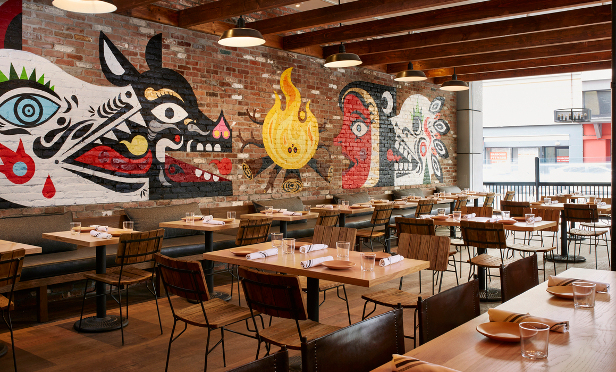
SAN DIEGO—By providing hotel amenities that enhance the dining experience and make the environment memorable, patrons are enticed to return even if they're not staying at the hotel, Ware Malcomb principal Tiffany English tells GlobeSt.com. As we recently reported, the architectural and design firm recently completed the new restaurant, bar and lounge area of the Kimpton Hotel Palomar, located at 1047 5th Ave. in Downtown San Diego, as architect of record for the project, in addition to providing brand-enhancing graphics for the interior and exterior design.
The project involved the two-story renovation of the restaurant and bar on the first floor of the Hotel Palomar, as well as an open space designed for a combination of private dining, a game room and a lounge area on the second-floor mezzanine level. The hotel's new restaurant concept, named Curadero, serves Mexican street food in a casual atmosphere, while the second-floor Arriba Room features a late-night taco window, vintage arcade games, foosball, shuffleboard, and other activities. Mexican-themed artwork and design are woven throughout the space.
The project was a collaboration with Studio Unltd, an interior designer based in Los Angeles. The general contractor for the project was RSM2, and JLL was the owner's representative and project manager on behalf of the hotel.
We spoke with English about what makes this project unique as well as emerging hotel-restaurant design trends and their drivers.

GlobeSt.com: What makes Hotel Palomar's restaurant distinct from other hotel restaurants in Downtown San Diego?
English: Curadero establishes a truly unique regional experience that connects with the Downtown San Diego culture. Providing the hotel guests and restaurant patrons with a hip, casual and highly textured ambiance, Curadero is more than just a “hotel restaurant.” The design aesthetic creates a destination that embodies the vibrant culture in San Diego, and provides a relaxed atmosphere for guests and patrons to enjoy.
GlobeSt.com: What design trends are emerging for hotel restaurants, and what is driving these trends?
English: Hotel restaurants are moving past serving only the hotel guests. By providing amenities that enhance the dining experience and make the environment memorable, patrons are enticed to return. Driving these trends is the increased focus on the overall customer experience. Incorporating vintage arcade games, foosball, shuffleboard and other activities into the design of a restaurant creates a fun, lively vibe, as seen in the design of Curadero. Through a unique menu, engaging amenities and creative art and design, Curadero is an inviting atmosphere for guests and patrons alike.
GlobeSt.com: What are hotel restaurants moving away from in their design choices?
English: Hotel restaurants are moving away from a purely functional dining venue. Expanding their exposure and appeal to the broader market is central to the design objectives, while still catering to the hotel guests.
GlobeSt.com: What else should our readers know about this topic?
English: Enhancing the customer experience is paramount to hospitality design. Designing spaces that attract guests seeking a unique experience is key. Branding the environment through arts and graphics brings the experience to life, and reinforces local design themes to create memorable spaces.


SAN DIEGO—By providing hotel amenities that enhance the dining experience and make the environment memorable, patrons are enticed to return even if they're not staying at the hotel, Ware Malcomb principal Tiffany English tells GlobeSt.com. As we recently reported, the architectural and design firm recently completed the new restaurant, bar and lounge area of the Kimpton Hotel Palomar, located at 1047 5th Ave. in Downtown San Diego, as architect of record for the project, in addition to providing brand-enhancing graphics for the interior and exterior design.
The project involved the two-story renovation of the restaurant and bar on the first floor of the Hotel Palomar, as well as an open space designed for a combination of private dining, a game room and a lounge area on the second-floor mezzanine level. The hotel's new restaurant concept, named Curadero, serves Mexican street food in a casual atmosphere, while the second-floor Arriba Room features a late-night taco window, vintage arcade games, foosball, shuffleboard, and other activities. Mexican-themed artwork and design are woven throughout the space.
The project was a collaboration with Studio Unltd, an interior designer based in Los Angeles. The general contractor for the project was RSM2, and JLL was the owner's representative and project manager on behalf of the hotel.
We spoke with English about what makes this project unique as well as emerging hotel-restaurant design trends and their drivers.

GlobeSt.com: What makes Hotel Palomar's restaurant distinct from other hotel restaurants in Downtown San Diego?
English: Curadero establishes a truly unique regional experience that connects with the Downtown San Diego culture. Providing the hotel guests and restaurant patrons with a hip, casual and highly textured ambiance, Curadero is more than just a “hotel restaurant.” The design aesthetic creates a destination that embodies the vibrant culture in San Diego, and provides a relaxed atmosphere for guests and patrons to enjoy.
GlobeSt.com: What design trends are emerging for hotel restaurants, and what is driving these trends?
English: Hotel restaurants are moving past serving only the hotel guests. By providing amenities that enhance the dining experience and make the environment memorable, patrons are enticed to return. Driving these trends is the increased focus on the overall customer experience. Incorporating vintage arcade games, foosball, shuffleboard and other activities into the design of a restaurant creates a fun, lively vibe, as seen in the design of Curadero. Through a unique menu, engaging amenities and creative art and design, Curadero is an inviting atmosphere for guests and patrons alike.
GlobeSt.com: What are hotel restaurants moving away from in their design choices?
English: Hotel restaurants are moving away from a purely functional dining venue. Expanding their exposure and appeal to the broader market is central to the design objectives, while still catering to the hotel guests.
GlobeSt.com: What else should our readers know about this topic?
English: Enhancing the customer experience is paramount to hospitality design. Designing spaces that attract guests seeking a unique experience is key. Branding the environment through arts and graphics brings the experience to life, and reinforces local design themes to create memorable spaces.

© Touchpoint Markets, All Rights Reserved. Request academic re-use from www.copyright.com. All other uses, submit a request to [email protected]. For more inforrmation visit Asset & Logo Licensing.






